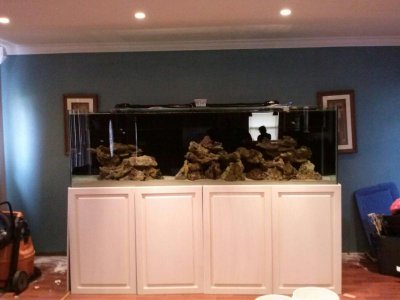I think there are a number of ways to go to get good lighting for your aquarium, but in the end it is your personal taste to decide. The aquarium is also large which makes it very well could work with both bright areas and areas with less light to get the most vibrant aquarium as possible Since the aquarium is so deep I'd probably use the 100 watt chip based on Epistar (the ones going to drive up to 250 W). Personally, I would probably choose the all-white chip (16 - 20 000 K) as a base.
I should also prefer to work with lenses. Dimmable drivers is a prerequisite and Mean Well HLG-185h-36 B is a good choice (HLG-185h-42 B would work as well) If you use this drivers you should start with only 60 - 70 % of the real capacity - the reason why I suggest this drivers is because you will have possibilties to rise the output if you need. If you want to be more "safe" the HLG-150H-36B is a good choise
To get to the important blue wavelengths, I have been thinking about working with a 100 watt in the center and have blue chip around. Still the same fixture. The same idea that I worked with in
this project. You can se the blending
here. However you need more space between the chip´s so you can fit in the lenses.
If you put all of this chip´s together at the same fixture you must have a good thermal solution. Let us say that you have one "100 W" sorrunded by six 20 W RB in different wavelenghts - you mayby need to take away 250 watts of heat. I have tested a soution where I have a aluminum plate between the chip´s and a heatpipe cooler and it works well. In this case you need a better cooler than I have - the one mentioned by ronreef (# 1520) will probably work well.
A good driver to 3 pieces of 20 watts in a daisy chain should be HLG-80H-42B (with a current of 1.95 A the FV of three chip in a daisy chain will be around 30 - 32 V (the AC-RC 20 watt chip) and you will use around 60 W.
I should use 90 or 120 degree lens to the white in the middle and 60 degree lens to the 20 watts.
I think that three of this monsters should bee a good start

Another pathway is ronreefs idea with a gooseneck. The good thing with this idea is that you have the ability to direct the beam where you want it. In this case I probably should use up to 6 chip (Epistar 100 W) and mix white 16 - 20 000 K with RB with 445 nm wavelenght.
In the future you probably also want to use 420 nm chip, with the "monster" solution you just incoperate them from the beginning - with the "gooseneck" solution you can add a bar with them along the backside of the aquarium.
This is my idea´s and if you take them, put them down together with your own idea´s (and other people´s as well) in a melting pot - I´m sure it will come out something good from this
Sincerely Lasse

